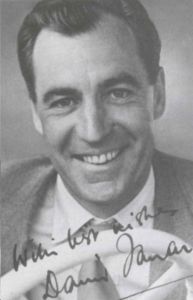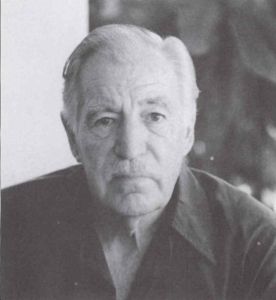Submitted by:
Tipu
Whatever became of ... David Farrar
From: Whatever became of ...
All new, tenth series
By: Richard Lamparski, 1986

| David Farrar's favorite photograph of himself, taken at London's Theatrical Garden Party in 1950. He likes it, "because it is one of the few times I looked cheerful!" |
|
The heroic English star was born on August 21, 1908, in Essex.
[or possibly Forest Gate, London]
Of his childhood he writes: "Apparently showed historical leanings from early age as I played Shakespearean roles at school."
After some time spent with a repertory school & then in touring companies, David became actor-manager of his own company in 1930. The same year he took over the lead in The Wandering Jew in the West End, bringing notices that immediately established him as one of the most promising young leading men in the West End.
He took over London's Grafton Theatre [on the Tottenham Court Road] for a series of plays, as he puts it: "Of course, playing the leads. As George Arliss once said, 'Well, there's one advantage of having your own theatre - you can always choose the best parts.'"
He says he was "lured" into films in 1937 when he made his screen debut in The Face Behind the Scar. Until the war broke out his screen career consisted of' 'big parts in small pictures and small parts in big pictures," according to Farrar.
Shortly after a bomb hit his theatre he was called up by the Ministry of War and put to work making propaganda films. He is responsible for the feature For Those in Peril (1944), much of which was shot during actual maneuvers in the English Channel.
The Dark Tower (1943) with the late Ben Lyon and They Met in the Dark (1943) came out during the War. Immediately afterward he made Lisbon Story (1946), now a cult film because of the appearance in it of the legendary tenor Richard Tauber.
When David Farrar arrived in New York City in 1947, his film Frieda, which introduced Mai Zetterling to the world and was a smash hit in Europe, was playing at one Broadway theatre and Black Narcissus at another.
Black Narcissus (1947), which costarred Deborah Kerr, was about sexual frustration and madness among a group of Anglican nuns. The Roman Catholic Church, through its Legion of Decency, deemed it a mortal sin for any member of the religion to view the film. It was rated "C" for "condemned" until a few minutes of footage were edited out. After the ban was lifted, it did very well at the box office in the United States and won two Oscars.
The Wild Heart (1950) with Jennifer Jones was nowhere near the success in the United States that it was in England under the title Gone to Earth.
He was offered the lead role of Edvard Grieg in the screen version of The Song of Norway, but the movie was to be shot in Hollywood and Farrar was committed in England. Once he was contractually free, there began years of commuting between Hollywood and London, starting with The Golden Horde (1951).
After that he appeared in Night Without Stars (1951) with Nadia Gray, Obsessed (1951) with Geraldine Fitzgerald, Duel in the Jungle (1954) with George Coulouris, Lilacs in the Spring (1954) with Anna Neagle, Tears for Simon (1957) [aka Lost], Solomon and Sheba (1958), John Paul Jones (1959) with Bette Davis, Middle of Nowhere (1960) [aka The Webster Boy (1962)], and Wild for Kicks (1962) [aka Beat Girl (1960)] with Shirley Anne Field.
United States television viewers probably know him best for his portrayal of the strong, silent "Mr. Dean" in Black Narcissus and the "Black Duke" in Son of Robin Hood (1958).
Farrar believes there were two major "might have beens" in his career. He could have played the villain in the 1952 version of Ivanhoe, but declined because it was not the title role. As he now admits, "The part I had been offered, which was subsequently played by George Sanders [Sir Brian De Bois-Guilbert ], was the most colorful. In retrospect it was a bad mistake." He would have played the title role in Ethan Frome, but the film was never made. Bette Davis, who was to have been his costar, told him it was canceled when she became pregnant. [It was finally made in 1993 with Liam Neeson and Joan Allen]
In 1962 he played Xerxes, which he considered to be a "wonderful, flamboyant part," in The 300 Spartans, and "then I quit while the going was good!"

| David Farrar, a widower, lives near his daughter on the Natal coast of the Republic of South Africa. |
|
David met his wife, Irene Elliot, in 1926 when he was playing the title role on stage in David Copperfield. He describes her as an "actress and beautiful pianist" After she died in 1976, he followed their only child [Barbara] to the Natal coast of the Republic of South Africa.
He admits to having made no effort to keep in touch with those he knew in England and, has been rumored dead among his profession.
He lives with his dog, a few miles from his daughter. Farrar describes his activities as "a bit of writing and painting. I play the piano to myself and get in eighteen holes of golf three times a week. I read a lot and average fifteen crossword puzzles a week."
He sums up his career thusly: "Tough, frustrating, but with many wonderful moments and memories. I found being a star a lonely business. I have no friends. Ain't that sad?"
Back to
Reviews



